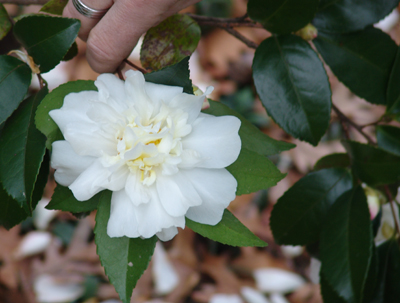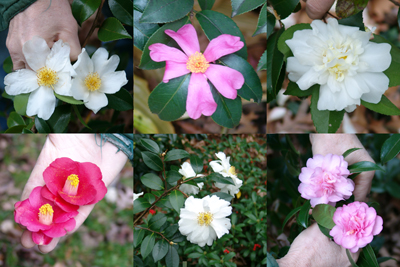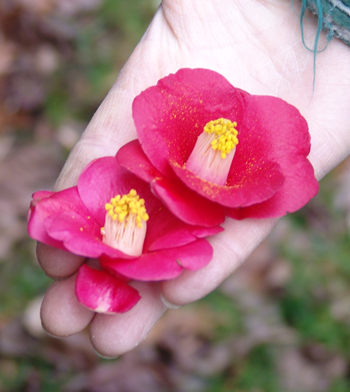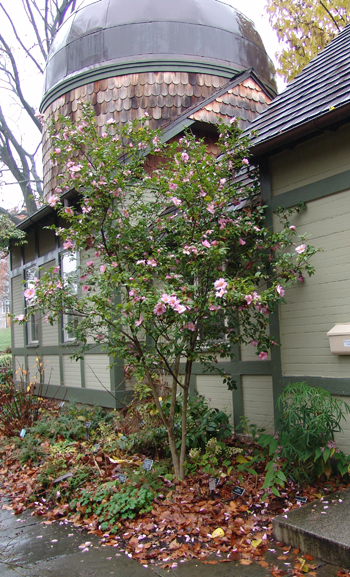
Last weekend I was fortunate enough to visit the Swarthmore garden of the renown plantsman Charles Cresson. I had visited the property several years ago during the spring season with a professor and I remembered it being very impressive, so I immediately realized I was in for a treat. Across his garden, camellias were unapologetically strutting their stuff. Flowers of every variety, consisting of blood reds, pinks, whites, doubles, and anemone tones, were apparent in every pocket of the garden.
Aesthetically, the floral display was spectacular, but the background stories Charles explained in detail were equally as elaborate. Charles delved into the history of each cultivar, complete with parentage, its origin, and the attributes that make it a worthy garden addition.

Camellia 'Winter's Interlude' photo credit: S. Keitch
The sources of Charles’ camellias are the J.C. Raulston Arboretum, the U.S. National Arboretum, the Morris Arboretum, Camellia Forest Nursery, and Dr. William Ackerman’s seedlings. Many of Charles’s specimens are from original cuttings obtained decades ago, many of which are Ackerman’s original seedlings.

Top Row, Left to Right: C. 'NCSU #5', C. 'Ackerman 79-897', C. 'Snowflurrry'. Bottom Row, Left to Right: C. japonica, seedling of 'Snowflurry', C. 'Winter's Interlude'. photo credit: S. Keitch
To better understand breeders’ goals, several species and their ornamental attributes should be recognized. Personally, I enjoyed the anecdote of Camellia oleifera, which survived the brutal winters of the ‘70s while other plantings perished. It has since been extensively incorporated into breeding programs, including the Ackerman program, for its winter hardiness. The specimen of Camellia oleifera ‘Lu Shan Snow’ was very impressive with its large white flowers, but its sexy cinnamon colored bark is what truly captivated me. Camellia oleifera is also an important crop in its native range in China, where its seeds are used to produce a valuable tea-oil.
Camellia sasanqua is another heavily bred species, with more subtle characteristics. It has noticeably smaller leaves and thinner flowers, but this is in no way a negative aspect. It is a parent of countless cultivars, a favorite being a hybrid with Camellia oleifera, ‘Carolina Moonmist’.

Camellia japonica from wild collected Korean seed. photo credit: S. Keitch
Then there are the spring blooming varieties, derived from Camellia japonica. During the eighties, expeditions focused on these colder locations to find more resilient offspring. The spring blooming varieties consist mostly of Camellia japonica parentage. These flowers are big and ostentatious, consisting of white, pink and red tones, and the glossy foliage is larger than other species.
There were many other rare species, and unusual hybrids collected by Charles, all outstanding with their unique traits. Charles also introduced me to several species I was unaware of, Camellia cuspidata, C. chekiangoleosa, and the mid-blooming hybrids C. X vernalis and C. X hyemalis.
These hybrids exemplify the potential of camellias in the landscape. As breeding continues, and hardiness boundaries are tested, camellias will soon gain a more dominant role in the landscape. Soon, one will be able to select which floral structure, color, and bloom period is desirable and a cultivar with those traits will exist. When it comes to floriferous evergreen shrubs, only rhododendrons are comparable.
Of course, this means that we will all inherit a dilemma, having to choose between rhododendrons and camellias. In my mind, context always dictates a plant palette, but if one were comparing the two side by side, it would come down to personal preference. The sleek and lustrous foliage of the camellia and its long bloom period are assets that should make camellias included by more designers. I would encourage everyone to take a chance and try something new, something bold, especially as the plethora of new cultivars on the market continues to grow.

Camellia (Ackerman 80-276) photo credit: R. Robert
Several camellias are in bloom at the Scott Arboretum, many of which are descendants of the Ackerman program, including Camellia ‘Winter’s Interlude’ in the Harry Wood Garden. We also recently added Camellia (Ackerman 80-276) to the Terry Shane Teaching Garden. This unnamed selection was donate by donated Charles Cresson and shows much promise.
